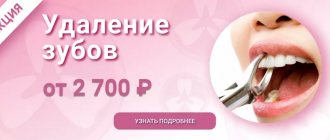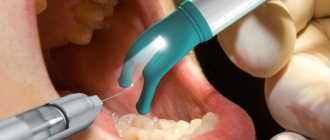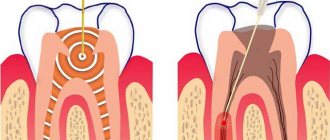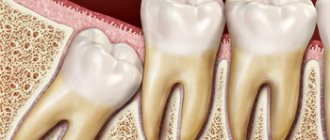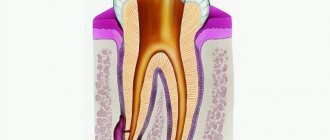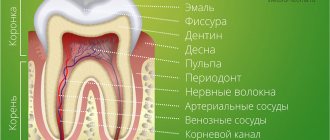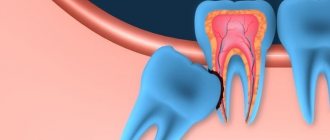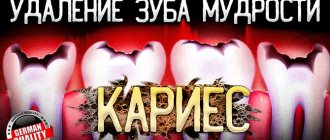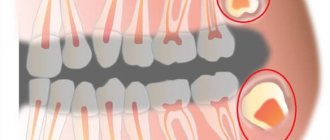- When is it necessary to remove the lower wisdom tooth?
- Tooth eruption problems. Wisdom teeth removal in advance
- Indications and contraindications
- Preparation for the procedure
- Removal steps
- Possible complications after removal
- Time and prices for the procedure
- Advantages of treatment at Aurora
Removal of a wisdom tooth on the lower jaw
Most people of conscious age go to the dentist because of problems with their lower wisdom teeth.
They often interfere, put pressure on neighboring molars, and cause discomfort or pain after eating. Most often, wisdom teeth in the lower jaw appear between the ages of 20 and 25, although the timing varies from person to person; for some, they may appear at the age of 16, for others closer to 40 years. In most cases, the appearance of figure eights is accompanied by various complications that require their removal. Malocclusion, difficulty in teething, tumors and trauma to the mucous membrane and much more.
Features of tooth extraction in the upper jaw
The structure of the upper and lower jaws is significantly different. They also vary in density and location. Therefore, the method of tooth extraction will differ:
- on the upper jaw the operation is faster;
- the recovery period is shorter;
- pain relief is simpler and more effective.
Complications during tooth extraction in the upper jaw occur less frequently than in the lower jaw.
Anesthesia
The secret of high-quality pain relief is the correct delivery of the drug to the nerve. The choice of anesthesia method takes into account the patient’s age, his general condition, and the complexity of the tooth being removed.
Anesthesia of the upper jaw
The upper jaw is less dense than the lower jaw. It is covered with a cortical plate with many holes. Nerves and blood vessels pass through them. Pain relief is easier and faster than in the lower jaw
Sinus damage
Above the upper jaw is the nasal sinus, also known as the maxillary sinus. Its bottom may be close to the root of the tooth being removed. Then, during removal, sinus perforation may occur. This complication is typical for surgery on molars. This pattern is explained by the fact that the jaw in the area of the incisors is longer, and the nasal cavity is further away relative to them.
The main sign of sinus perforation is the escape of air, food and fluid through the nose. There is foam in the hole. Hospitalization in a hospital may be indicated for treatment.
Entry of part of the root into the sinus
Due to perforation of the sinus, part of the root can get inside it. This is caused by thinning of the bone plate or errors during the removal operation.
The symptoms when part of the root gets into the sinus are the same as when perforation occurs: air and contents of the oral cavity escape through the nose. But at the same time there is pain and increased body temperature. Treatment requires hospitalization.
When is it necessary to remove the lower wisdom tooth?
Eighth teeth are removed in two cases: when they have not yet sprouted or are already protruding from the gums. In the first case, the operation is performed if the patient feels discomfort, and during an external examination the doctor does not see diseased teeth. The appearance of pain means that the molar in the gum is pressing on its neighbor and disturbing him.
If the wisdom tooth has erupted incorrectly - that is, not straight up, but with a deviation, at an angle to the jaw and neighboring teeth, then removal is also a mandatory procedure. The slope of the figure eight is:
- distal - when the “eight” is tilted back, away from the “seven”. In this case, there is a risk of injury to the gums and damage to the roots of the adjacent tooth;
- medial - when the “eight”, on the contrary, is inclined towards the neighboring tooth. This increases the likelihood of damage to the crown part of the “seven” and the development of caries on both teeth;
- buccal – in this case, the wisdom tooth is turned towards the cheek and constantly touches the mucous membrane, causing irritation and hardening of the tissues. This condition can eventually lead to the formation of a tumor on the mucosa.
The removal of a wisdom tooth in the lower jaw is definitely necessary in the following cases:
- Caries on a wisdom tooth.
- Lack of space in the row for teeth. The last molars put pressure and cause discomfort.
- Pain in the gum where the wisdom tooth is located, at any time of the day, even after sleep.
- Incorrect growth sideways towards the tongue or larynx. This phenomenon is called dystopia.
- It interferes with implantation.
A tooth can erupt without causing pain once it appears; it will still be removed because it is not growing properly. The dentist makes an accurate diagnosis. To make an appointment, leave a request on the website or call one of the numbers: +7-924-444-05-45 - administrator
Removing a wisdom tooth in the lower jaw is a more complex procedure than removing an upper tooth. The bottom eights have a more powerful root system, and the jaw bones are denser and thicker. To remove a lower molar, it is necessary to perform a complex operation with dissection of the gum. In some cases, the surgeon has to remove part of the bone, divide the root into several parts and extract them separately.
Sign up for a free consultation
Prices
| Wisdom tooth removal | Price |
| Removal of the 8th tooth, I degree of difficulty | 3,500 rub. |
| Removal of the 8th tooth of II degree of difficulty | RUB 3,800 |
| Removal of the 8th tooth of III degree of complexity | 7,300 rub. |
| Initial consultation with a specialized specialist and drawing up a detailed treatment plan | For free |
Wisdom teeth are the last to erupt and complete the dentition. The peculiarities of their growth, location and anatomical structure of the root system often become the cause of complicated treatment or serious pathologies that require removal of the wisdom tooth.
Tooth eruption problems. Wisdom tooth removal in advance
Many patients think that if the wisdom tooth is not visible on the gum, then there is no need to worry. However, over time, this molar increases in size and begins to interfere with the others. Waiting until the wisdom molar appears can lead to the following problems:
- pain in the tooth and gum;
- caries between molars;
- curvature of the roots of a healthy chewing tooth;
- infection in the place where the molar erupts because it grows incorrectly;
- curvature of the bite.
It is easier for a doctor to pick up and remove a tooth that has not yet come out. So while there is no pain, it is better to have surgery in advance.
Why remove wisdom teeth
Third molars are rarely preserved - they are destroyed early or removal is necessary for the proper functioning of the dentition. Most dentists prefer to remove pathological 8 even before they can seriously harm the health of the jaw (especially the lower one) of the entire row.
Cannot be deleted
wisdom tooth in the absence of the 6th and 7th molars. A contraindication to extraction is inflammation of the periodontium, root, bone or gum, since there is a danger of spread and aggravation of the pathological process against the background of a postoperative wound. The limitations to surgical extraction of third molars are:
- location 8 in the area of malignancy;
- pregnancy;
- hypertension stage II-III;
- suffered a heart attack or stroke less than 3 months ago.
All operations, including dental ones, in these cases are carried out after consultation with the patient's attending physician.
Indications and contraindications
The attending physician (therapist) or orthodontist directs the removal of a molar in the lower jaw. In any case, the patient is sent for a panoramic photo, where the location of the teeth is visible. This procedure facilitates the work of the surgeon who has to deal with a complex operation. Contraindications for removal are as follows:
- Pregnancy and breastfeeding. After such a complex removal, the mother will have to stop breastfeeding, because antibiotics and painkillers can get into the baby along with the milk.
- People of the older generation with a diseased heart, hypertension of the 2nd or 3rd degree should be attentive to their health and not rush into surgery, but it is better to refuse it altogether.
- Malignant formation in the tooth growth zone.
Tooth extraction is also done as a preventive measure in advance, so that later they do not hurt and do not interfere with others.
What you need to know before surgery
Before surgery, you need to find out what is paid and what is free under compulsory medical insurance. It is important to know that you will have to pay extra for some related services, for example, for anesthesia, consumables, and x-ray film. As a rule, this is a small amount, but you need to take the money with you for the operation.
Important! All medications included in the vital list are provided free of charge. These are lidocaine, novocaine, arsenic and arsenic-free drugs. Also included in the free list are consumables (bandages, cotton wool, syringes) and filling materials.
It is necessary to ask your doctor in advance about possible risks and complications after wisdom tooth removal. Negative consequences include increased body temperature, swelling of the gums, the appearance of a cyst, bruises on the cheek, and pain when opening the jaw. The most dangerous complication that requires emergency medical attention is severe bleeding.
Related article: Is laparoscopy included in the compulsory medical insurance program?
All services included in the compulsory medical insurance program must be provided free of charge. If they demand money from a patient, then you need to call the insurance company. The Investigative Committee representative will tell you what to do in this case and who to complain to. It is necessary to defend your right to receive free dental care, since the patient is not treated for free, the state pays for it.
Preparation for the procedure
Before removing a tooth, it is necessary to undergo a computed tomogram (CT ). The device allows you to illuminate the teeth and see the location of the crowns and roots in the gums. CT will make the surgeon’s work easier and save him from a long and complex operation. The procedure is painless. Done quickly.
The choice of tooth extraction technique depends on several factors:
- the presence or absence of inflammation of the soft tissues surrounding the tooth,
- duration of the process,
- location of the third molar in the bone,
- contacting a doctor during periods of exacerbation or remission of the disease,
- degree of tooth crown destruction.
How is the operation performed?
The technique depends on the clinical picture, the patient’s testimony, and the tactics chosen by the specialist.
| Simple | Complex |
|
|
Despite the fact that after a simple intervention, sutures, as a rule, are not applied, experienced specialists still bring the edges of the mucosal wound closer together in order to minimize the likelihood of bleeding or prolapse of a clot and the development of alveolitis (dry socket).
The extraction of the “figure eight” is considered the most difficult in terms of execution if the mandibular nerve is located near it. The doctor should carry out manipulations in such a way as not to catch it. If there is a cystic formation at the apex, you must not damage it and clean the cavity well after removal.
Removal steps
The procedure can be divided into three stages:
- preparatory;
- The operation itself;
- After surgery.
Preparatory stage.
At this stage, the doctor visually examines the patient's oral cavity. Then a computed tomography is done to look at the length and shape of the roots, the depth of the tooth, etc.
Surgery
Complex wisdom tooth removal is divided into several stages. Let's consider a generalized operation scheme:
- A painkiller is given. To do this, a needle is inserted into the lower jaw to the nerve bundle so that the patient does not feel pain. Lips, chin, tongue are numbed. If sensitivity does not disappear, an additional injection is given. After anesthesia, the course of a complex extraction procedure depends on the location of the tooth.
- An incision is made with a scalpel.
- The tooth is sawed down to make it easier to remove.
- Take out the crown and roots.
- The wound is treated and sutured.
This completes the surgical stage.
Postoperative stage
This stage is very important, its duration is 7 – 10 days. During this period, the surgical wound heals, and a clot first forms in the hole and then resolves. Patients must follow our doctor's instructions exactly to avoid post-operative complications.
Tooth extraction: how long does the procedure take?
With a simple type of extraction, the procedure is carried out in 10 - 20 minutes. The process of complex removal lasts from 30 minutes or longer, depending on the specifics of the operation. For example, removing a horizontal tooth can take up to 2 hours or more. At the same time, sometimes additional preparatory procedures are necessary, which also take time.
After tooth extraction in the lower jaw antibiotics to prevent the entry and spread of infection. Such complex manipulations are contraindicated for pregnant and nursing mothers. Painkillers are prescribed to reduce pain after the procedure.
For complex removal, the patient is asked to come back again in five days or earlier if a fever appears. If the tooth has come out halfway (semi-retinated tooth), removal is carried out in the same way, but it is easier to pull it out, since part of the molar is on the surface.
Removal of a tooth
Removal of a tooth
- manipulation is responsible and important. Removal of a molar tooth is resorted to only if there is irrefutable evidence. Tooth extraction is a last resort measure, which is resorted to if it is impossible to solve the problem in any other way.
Why should this be done in our clinic?
At the Federal Scientific Clinical Center, tooth extraction is performed in the most gentle way possible, using modern instruments (including the VarioSurg ultrasonic device), which minimize discomfort in the postoperative period and allow you to preserve the maximum volume of bone tissue.
Indications
- Teeth with impassable root canals with chronic peri-radicular periodontitis, cysts, especially complicated by sinusitis, neuralgia
- Inability to save a damaged tooth
- Third degree tooth mobility
- Atypical position of wisdom teeth or other teeth that injure the mucous membrane, interfere with food intake and speech function
- Supernumerary and impacted teeth causing pain or inflammation
- Mechanical damage to the tooth (fractures of crowns, roots)
- Teeth on the jaw fracture line
- Tumors of the jaw
- During orthodontic treatment
- During orthopedic treatment (single teeth that interfere with the stabilization of the prosthesis)
Contraindications
- For some acute diseases (myocardial infarction, hypertensive crisis, stroke).
- In the acute stage of infectious diseases (influenza, ARVI, tonsillitis, diphtheria, hepatitis A, etc.)
- When taking medications that reduce blood clotting (for example, Thrombo ACC).
- In the first and last trimester of pregnancy.
- During menstruation (due to poor blood clotting).
In patients with hemophilia, tooth extraction should be performed in a hospital.
Tooth extractions are often classified as simple or complex. Simple extractions are performed on teeth whose crowns or roots are clearly visible and can be securely fixed with forceps.
Methodology
After anesthesia is administered, the tooth is gradually rocked, rotated and luxated; it is possible to section the tooth into several parts for more gentle removal. After tooth extraction, the hole is treated with an antiseptic solution, curettage of the hole is performed, and pathological formations are removed; then an antimicrobial agent is placed in the hole, and recommendations are given.
Recommendations after removal
- Do not spit saliva for 24 hours after removal - this may cause bleeding.
- You should not eat for 2 hours after removal - this is necessary to organize and strengthen the blood clot in the socket.
- You cannot examine the hole yourself with your finger, tongue, toothpick or other objects. By doing this, you destroy the integrity of the blood clot, expose the wound surface of the bone, and a huge number of bacteria and their toxins from the oral cavity rush there, causing pain and subsequent inflammation of the hole (alveolitis).
- on the day of removal and, preferably, the next, do not take a hot bath or go to the sauna. These heat treatments dilate the blood vessels and may cause bleeding from the socket.
- For the same reason, it is not recommended to sleep on the removal side and place your palm on your cheek.
- Do not eat spicy or very hot foods for 2-3 days after removal.
Despite the popular belief that tooth extraction is an ordinary procedure, all the above points must be strictly observed, which guarantees quick and painless healing.
Possible complications after removal
Complications after surgery arise due to violations of doctors’ recommendations. Patients begin to rinse their mouth, go to the bathhouse, play sports, or do not take medications that were prescribed. It is absolutely IMPOSSIBLE to do this for 5 days, because the place where the tooth was located is easily inflamed. Pain after removal is normal. Because the anesthesia wears off and the gums heal. Taking painkillers reduces pain.
Without taking antibiotics, inflammation and suppuration may begin. This situation arises due to the fact that food often accumulates at the end of the gums, which is difficult to remove with a brush, and along with it remain microbes that cause suppuration.
If bleeding occurs after removal, you should press the wound with a cotton pad for 15 minutes. If the bleeding does not stop, you should consult a doctor.
For reference! For high-quality and rapid healing, it is necessary that the wound heals well, so you should not eat hard food for at least 5 days and clean the hole.
Which clinic can I go to?
You can have a tooth removed for free in public and private clinics that provide compulsory medical insurance services.
List of medical organizations that you can contact for wisdom tooth removal:
- “Dentistry on Proletarskaya”, Nizhny Novgorod;
- dental clinic "NAVA", Moscow;
- "Doctor Smile", Moscow;
- LLC "Dentistry 20", St. Petersburg;
- "Hummingbird", Izhevsk;
- JSC "City Dentistry", Kazan;
- LLC "Dentistry", St. Petersburg;
- City dental clinic No. 1, St. Petersburg.
The full list can be found on the website of the Russian Ministry of Health.
How to treat teeth in a private clinic for free
First, you need to find out which private clinics operate in the compulsory medical insurance system. Then contact the one you like, taking with you your passport, SNILS and insurance policy. After joining the clinic, the patient will have access to free compulsory medical insurance services.
The treatment process is similar to that in a public clinic:
- Join the clinic.
- Make an appointment with a doctor (by phone or at the reception).
- Get on the waiting list. You must be prepared for the fact that in a private clinic they will primarily serve patients for money. Although the state covers the costs of treatment for the insured, the funding is small. According to the compulsory medical insurance policy, patients can wait for their turn from two weeks to 2-3 months.
- Come to the dentist for an appointment. To remove a wisdom tooth, you first need to see a therapist; perhaps you can do without surgery. If surgery is necessary, you will need the help of a surgeon.
If the patient is not satisfied with the quality of service or other complaints arise, he has the opportunity to change the clinic once a year.
Time and prices for the procedure
This complex operation takes about an hour. The duration of the procedure depends on the complexity of the figure eight position and the degree of neglect.
The consultation is free of charge. The final cost can be found out after consulting a specialist.
| Name of service | Unit | Price |
| Primary appointment (examination, consultation) with a dental surgeon | units | 0 |
| Repeated appointment (examination, consultation) with a dental surgeon | units | 500 |
| Complex tooth extraction with root separation | units | 7000 |
| Removal of periodontitis tooth | units | 2000 |
| Removal of a permanent tooth | units | 4000 |
| Flap surgery in the oral cavity in the area of the 1st tooth | units | 2000 |
| Flap surgery in the oral cavity on periodontal tissues (convet flap displacement) | units | 6000 |
| Removing stitches | units | 200 |
| Suturing the oral mucosa | units | 500 |
| The operation of removing an impacted, dystopic or supernumerary tooth | units | 8000 |
| Stopping alveolar bleeding without suturing using hemostatic materials | units | 500 |
A detailed price list can be found on the website.
Patient ReminderLIST OF DENTAL SERVICES INCLUDED IN THE COMPLIANCE PROGRAM
Therapeutic dentistry and periodontology:
- Appointment with a dentist;
- Treatment of caries and non-carious lesions of teeth using chemically cured filling materials of domestic production in cases of tooth decay of less than 50%;
- Treatment of pulpitis (inflammation of the nerve of the tooth) using endodontic instruments and filling materials of domestic production;
- Treatment of periodontitis (inflammation of the tissues surrounding the tooth root) using endodontic instruments and domestically produced filling materials;
- Removal of dental deposits (tartar above and below the gum) by manual mechanical method simultaneously in the area of up to six teeth;
- Treatment of inflammatory diseases of the oral mucosa and gums (gingivitis, periodontitis, stomatitis) using domestically produced medicines with the exception of surgical treatment methods;
- Anesthesia during dental treatment using anesthetics and standard disposable syringes of domestic production;
- Treatment of dental hypersensitivity (hypersensitivity) using domestically produced fluoride-containing preparations;
- Grinding of hard dental tissues;
Surgical dentistry:
- Appointment with a dentist-surgeon;
- Simple and complex tooth extraction, including the removal of dystopic and impacted teeth (with anomalies in location) for medical reasons (except for preparing teeth for prosthetics and for orthodontic reasons);
- Anesthesia during dental treatment using anesthetics and standard disposable syringes of domestic production;
- Treatment of pericoronitis (excision of the hood) with difficult teething;
- Treatment of alveolitis (inflammation of the socket of an extracted tooth) with curettage of the socket;
- Treatment of injuries to the maxillofacial area (splinting teeth in case of fracture, changing rubber traction and removing splints);
- Treatment of inflammatory diseases of the oral cavity: opening of a subperiosteal abscess, soft tissues in the oral cavity;
- Removal of bony protrusions;
- Removal of benign neoplasms in the periodontal area and oral mucosa;
- Treatment of diseases of the salivary glands (diagnosis of the disease, carrying out complex measures aimed at correcting immunity, influencing the pathological process in the salivary gland).
Orthopedic dentistry:
- The provision of orthopedic dental care to a preferential category of residents of the city of Moscow is regulated by the laws of the city of Moscow No. 70 of November 3, 2004 “On social support for a certain category of citizens of the city of Moscow”, No. 60 of November 23, 2005 “On social support for families with children in the city of Moscow” at the expense of the budget of the city of Moscow;
- Free production and repair of dentures, taking into account medical indications and contraindications, is carried out for preferential categories of citizens:
- disabled people and WWII participants; WWII veterans; Leningrad siege survivors;
- disabled people of groups I, II, III;
- labor veterans; “Honorary Donor of Russia” (“P.D. USSR”);
- rehabilitated persons and members of their families;
- home front workers; widows of WWII, UVOV;
- concentration camp prisoners; liquidators of the Chernobyl accident;
- military veterans;
- combatants;
- Afghanistan veterans;
- pensioners;
- mothers with many children (5 or more children).
The following types of work are performed:
- partial and complete removable laminar dentures (with the installation of a different number of plastic teeth from 1 to 14 per denture) from domestically produced material;
- simple clasp prostheses (support-retaining clasp, saddle, clasp arch);
- fixed dentures (single stamped crowns, restoration of the coronal part of the tooth with a stump pin, bridges: steel, plastic, metal-plastic, metal-ceramic, prostheses made of gold and precious metals) from domestically produced materials;
- removal and cementation of crowns;
- pain relief during orthopedic treatment using disposable standard syringes and domestically produced anesthetics;
- restoration (repair) of previously manufactured dentures, unless a new removable denture is made at the same time.
The cost of gold, precious metals and metal ceramics, and spraying on metal crowns (coating with titanium nitrate alloy) are paid additionally by the patient.
All orthopedic structures are manufactured strictly according to medical indications.
X-ray diagnostics
- orthopantomography (of the preferential category of the population for the purpose of dental prosthetics), if the patient subsequently receives services for preferential dental prosthetics in this institution;
- radiography and radiovisiography - intraoral targeted X-ray photographs of teeth (on film and paper).
LIST OF DENTAL SERVICES NOT INCLUDED IN THE COMPLIANCE PROGRAM AND STATE GUARANTEES
THERAPY
- Aesthetic restoration of teeth using light-curing materials;
- Light-curing fillings;
- Production of veneers by direct and indirect methods;
- The use of intracanal pins (fiberglass, parapulp, etc.);
- Treatment of root canals of teeth: treatment of root canals using NITI rotating machine instruments, filling of root canals using gutta-percha pins and imported pastes using various filling methods);
- Intra-canal whitening of pulpless (“dead”) teeth;
- Restoration of the tooth stump under an artificial crown from modern polymer and glass ionomer materials of imported origin;
- Depulpation of teeth under X-ray control in order to prepare teeth for dentures;
- Retreatment of teeth for the purpose of dental prosthetics previously treated in other health care facilities;
- Unsealing root canals for inlays for the purpose of dental prosthetics;
- Treatment of inflammatory periodontal diseases using modern methods (VECTOR device, laser, ultrasound therapy) and imported materials - targeted regeneration of soft tissues, splinting of mobile teeth, cosmetic closure of exposed tooth necks, etc.;
- Surgical methods for the treatment of periodontal diseases (open curettage, flap surgery, gingivoplasty, etc.);
- Anesthesia using imported carpule anesthetics;
- Prevention of dental diseases: professional oral hygiene, removal of dental plaque using an ultrasonic device, use of AIR-FLOW, removal of age spots, plaque, coating with imported fluoride-containing preparations, deep fluoridation of teeth, teeth whitening;
- Three-dimensional computed tomography of the maxillofacial region in 3D format;
- Orthopantomography of the maxillofacial area for persons over 18 years of age and of working age;
- X-ray examination in the provision of paid medical services and preparation for dentures.
SURGERY
- Surgical methods for the treatment of periodontal diseases (open curettage, flap surgery, gingivoplasty, etc.);
- Implantology, operations for guided bone regeneration and plastic surgery of soft tissues in the area of implants;
- Anesthesia using imported carpule anesthetics;
- Tooth extraction for orthodontic and orthopedic indications for persons over 18 years of age;
- Cystotomy;
- Cystectomy (removal of the root cyst);
- Plastic surgery of the frenulum of the upper or lower lip, frenulum of the tongue for persons over 18 years of age;
- Plastic surgery of scars and cords of the oral mucosa;
- Plastic surgery for gum recession, including connective tissue graft (local tissue);
- Resection of the root apex;
- Hemisection;
- Vestibuloplasty surgery;
- Correction of lip and tongue frenulum using a diode laser;
- Three-dimensional computed tomography of the maxillofacial region in 3D format;
- Orthopantomography of the maxillofacial area for persons over 18 years of age and of working age;
- X-ray examination in the provision of paid medical services and preparation for dentures.
ORTHOPEDICS
- Providing orthopedic treatment to persons over 18 years of age and of working age;
- Partial and complete removable laminar dentures made from imported material;
- Clasp dentures of varying degrees of complexity;
- Fixed dentures (single and bridge dentures: steel, plastic, metal-plastic, metal-ceramic, prostheses made of gold and precious metals) from imported materials;
- Prosthetics on implants;
- Anesthesia using imported carpule anesthetics;
- Depulpation of teeth under X-ray control in order to prepare teeth for dentures;
- Three-dimensional computed tomography of the maxillofacial region in 3D format, orthopantomography;
- Orthopantomography of the maxillofacial area for persons over 18 years of age and of working age;
- X-ray examination in the provision of paid medical services and preparation for dental prosthetics;
- Retreatment of teeth for the purpose of dental prosthetics previously treated in other health care facilities;
- Unsealing root canals for inlays for the purpose of dental prosthetics.
IN CASE OF PAYMENT FOR DENTAL SERVICES INCLUDED IN THE STATE GUARANTEES PROGRAM, please inform the Deputy General Director for Medical Affairs by phone 8-499-203-22-85 or the Head of the Department.
Sincerely,
Administration of JSC "MEDIUS S"
In accordance with the Federal Law of November 21, 2011 No. 323-FZ “On the fundamentals of protecting the health of citizens in the Russian Federation,” the Russian Government annually approves a program of state guarantees of free medical care to citizens for a period of three years (for the next financial year and for the planning period) .
Decree of the Government of the Russian Federation No. 1382 of December 19, 2015 approved the Program of State Guarantees for the provision of free medical care to citizens for 2016 (hereinafter referred to as the Program).
The goal of the Program is to ensure the constitutional rights of citizens to medical care at the expense of financial resources from all budgets of the budget system, including the budgets of compulsory health insurance funds (CHI).
The program establishes a list of types, forms and conditions of free medical care, a list of diseases and conditions for which medical care is provided free of charge, average standards for the volume of medical care, average standards for financial costs per unit of volume of medical care, average per capita financing standards, the procedure and structure of formation tariffs for medical care and methods of payment, requirements for territorial programs of state guarantees of free provision of medical care to citizens in terms of determining the procedure, conditions for its provision, criteria for accessibility and quality, a more detailed list of services can be found on the official website of the MGFIF https://www .mgfoms.ru/ .
Make an appointment for lower wisdom tooth removal
Byshlyaga Dmitry Yurievich
Byshlyaga Dmitry Yurievich Orthopedic dentist
Extensive practical experience. Regularly undergoes internships and advanced training courses.
Working hours: from 9.00 to 20.00, daily, seven days a week, by appointment
Make an appointment
More details
Asatryan Alexander Aramovich
Asatryan Alexander Aramovich Dentist therapist - orthopedist - surgeon
Extensive practical experience. Regularly undergoes internships and advanced training courses.
Working hours: from 9.00 to 20.00, daily, seven days a week, by appointment
Make an appointment
More details
×
Where to undergo removal in Moscow?
To ensure that the operation goes smoothly and the risk of complications is minimized, contact the Good Hands clinic in Lyublino. We employ highly qualified surgeons with many years of experience who have perfectly mastered removal techniques.
By choosing them correctly in a particular case, they minimally injure the gums, significantly shortening the rehabilitation period and eliminating negative consequences. The process uses the latest generation of anesthetic drugs. They are safe for the human body, but are effective enough to ensure good health.
You can find out the cost of removal by reading our price list, and clarify the numbers by contacting our operator. The best option is to sign up for a free consultation and get first-hand information.
Advantages of treatment at Aurora
Removing the lower wisdom tooth is a complex procedure that requires high specialist competence. Due to the inconvenient location and improper growth of the last molar, neighboring teeth suffer. Highly qualified specialists of our center easily and quickly carry out complex operations of this level. In addition, Aurora dentistry has other important advantages over its competitors:
- the possibility of receiving installments from Pochtabank or Renaissance Credit;
- individual approach;
- work on weekends, including for residents of the region by appointment;
- The doctor is assisted by an assistant, which allows him to carry out manipulations 2 times faster;
- modern, 100% high quality, imported materials.
Our dentistry offers the following promotions for the removal of the lower wisdom tooth:
- If you found out about us through 2GIS, we provide 5% on services;
- 10% discount on your birthday and the next 3 days
- For pensioners there is a “Golden Watch” promotion - a 10% discount on tooth extraction from 9-00 to 11-00
If you need complex and long-term dental treatment in Blagoveshchensk, we have an individual discount policy and a flexible payment schedule
To make an appointment, just call. On the appointed day, the doctor will see the patient and tell him how the lower wisdom tooth will be removed without pain after the procedure and fear.
What services do you not need to pay for?
Consultations with a dental therapist and dental surgeon are available under the compulsory medical insurance policy. In addition to them, the list includes the following services:
- scheduled inspection, which is required once every 6 months;
- treatment of caries and pulpitis using domestic filling materials;
- removal of tartar;
- treatment of periodontitis, inflammatory diseases of the oral cavity and gums;
- the use of fluoride-containing drugs to reduce tooth sensitivity;
- tooth extraction according to indications;
- treatment of alveolitis, pericoronitis;
- reduction of dislocations and subluxations;
- anesthesia;
- treatment of wounds in the oral cavity;
- opening of abscesses, removal of benign neoplasms;
- treatment of diseases of the salivary glands;
- physiotherapeutic procedures;
- X-ray examination.
Related article: Time to produce a compulsory health insurance policy
Note! Under the compulsory medical insurance policy, you can remove any permanent or baby tooth for free; both simple and complex surgical interventions are performed.
The clinic will have to pay for expensive imported filling material, for the manufacture of implants, consultation with a periodontist and orthodontist, for teeth whitening and other aesthetic dentistry services.
You can read more about dental services under compulsory medical insurance here.
Is it possible to remove a wisdom tooth under the compulsory medical insurance policy?
Surgical interventions in the oral cavity are equivalent to surgery. Regardless of the complexity, they are covered by the insurance policy. That is, according to compulsory medical insurance, wisdom tooth removal is free. However, it is necessary to take into account the nuances.
If you just come to the clinic and demand that your wisdom tooth be removed, then even despite your insurance policy, you will have to pay for the service out of your own pocket. Why is that? To remove a wisdom tooth under compulsory medical insurance, there must be medical indications and a referral from a doctor is required.
Important! Before removing teeth, it is worth finding out which services are paid and which are free. This list may differ in a particular dental clinic.
What is needed for removal
Removal of any tooth, not just wisdom, is carried out only according to indications. The patient's wishes are not enough.
When figure eights emerge, the jaw is already formed, so there is not enough room for them. Because of this, neighboring teeth suffer, and the wisdom teeth themselves quickly deteriorate and collapse.
Indications for removal:
- tooth decay;
- strong pain;
- formation of an abscess, swelling of the gums;
- incorrect position;
- eruption under adjacent teeth;
- caries;
- incomplete tooth eruption;
- close location of the roots to the maxillary sinus;
- malocclusion.
If such problems exist, removal is carried out free of charge under the compulsory health insurance policy.
A referral for surgery to the Department of Oral and Maxillofacial Surgery is issued by a dentist at the clinic at your place of residence. If complex intervention is required, the patient is sent to the hospital. After the tests are completed, surgery is performed.
Related article: Dental services under the compulsory medical insurance policy in 2019
When can they not be removed?
Modern dentistry clearly formulates its attitude towards figure eights - you don’t have to remove wisdom teeth provided:
- there is enough space for them to cut through;
- erupted molars occupy an anatomically correct position and do not harm neighboring units;
- nothing prevents the treatment of the eight;
- third molars do not impede hygienic care of teeth and gums;
- A wisdom tooth is needed as a support for fixing a bridge or other orthopedic system (if 7 is missing).
If the third molars are affected by caries, they somehow interfere with other units in the row or the chewing process, or regularly injure the mucous membrane - they must be removed. In this matter, world dentistry is ruthless; the presence of eights is allowed exactly as long as they do not harm the health of the dental system and do not disrupt its functionality.
